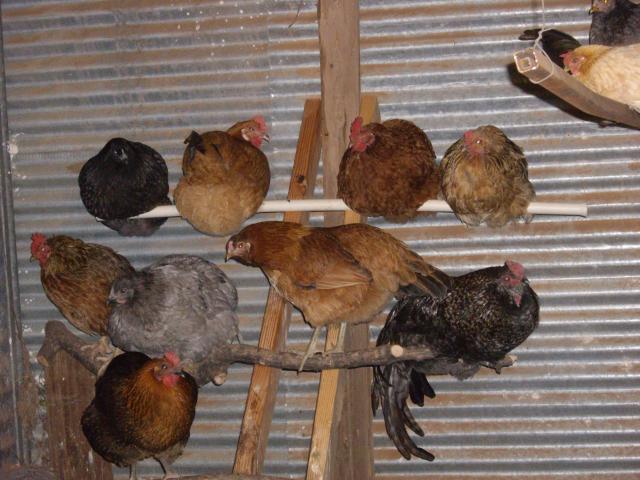Navigation
Install the app
How to install the app on iOS
Follow along with the video below to see how to install our site as a web app on your home screen.
Note: This feature may not be available in some browsers.
More options
You are using an out of date browser. It may not display this or other websites correctly.
You should upgrade or use an alternative browser.
You should upgrade or use an alternative browser.
Hidden Genes in White Birds?
- Thread starter ClintD
- Start date
Quote:
Hi ClintD I'm ClintT lol And welcome to BYC.
It is possible for any color to be hiding under white if if was bred for it. White Rocks like you mentioned can and usually do mask barring under their white. Since Barred Rocks were the original Rock variety, then in breeding them, the recessive white sports popped out and then were bred to be white. Recessive White is what is found in most solid white breeds. It, like all other recessive genes, requires two copies to be present so if you had White Rock that was masking barring, crossing it with another bird would be like crossing a regular barred rock with the another bird in the first generation. But now days will all the other varieties, its hard to know what color they are masking.
White Giants and White Javas are pretty much always masking black. But like I said the breeds like Rocks, Wyandottes, Cochins, and especially Silkies, theres really no way to know for sure what they are masking unless you know their genetic history. Most Solid White birds are recessive white.
Then White Leghorns as well as the Cornish Cross birds, are Dominant White instead of recessive white and these two breeds are usually masking silver based black. The silver accounts for why there is no red coming through since Dom White masks black but allows red to come through pretty well. And the black is why you dont get sexlinks from breeding with these two breeds becuase its like breeding with a black bird which would give you mainly black offspring but the Dom White masks the black in the offspring as well. So the White Leghorns, Cornish X, and some Games, are the only ones that I know of that are solid white but not recessive white. But if you see white in a bird that is showing red but not black, then you know that is also dominant white. Like Red Pyle, Buff Laced, and the White tailed red sexlinks are all colors were the white is making the black and letting the red through.
The other gene that can color a bird white is Sexlinked Silver. However Silver doesnt mask anything like Rec. and Dom. White. If you see white with black in a patterned bird, then that is Silver. Examples would be Delawares, Columbian colored birds (Light Sussex, Columbian Wyandottes, ect..), and anything with Silver in the name like Silver Duckwing, Silver laced, Silver Penciled, ect... Any hens with this color can be bred with Gold males to create sexlinked chicks that can be color sexed at day one.
And then there is Rhode Island Whites who are another solid white but non recessive white breed, they have a combination of both Dominant and Silver. They would be like a Silver Columbian colored bird like Light Sussex, with the black masked my Dom White. So they can produce sexlinks, but the black in the offspring is going to be masked by dom white and that is how some Gold Sexlinks get their white tail feathers which would normally be black if the mother only carried Silver.
Hi ClintD I'm ClintT lol And welcome to BYC.
It is possible for any color to be hiding under white if if was bred for it. White Rocks like you mentioned can and usually do mask barring under their white. Since Barred Rocks were the original Rock variety, then in breeding them, the recessive white sports popped out and then were bred to be white. Recessive White is what is found in most solid white breeds. It, like all other recessive genes, requires two copies to be present so if you had White Rock that was masking barring, crossing it with another bird would be like crossing a regular barred rock with the another bird in the first generation. But now days will all the other varieties, its hard to know what color they are masking.
White Giants and White Javas are pretty much always masking black. But like I said the breeds like Rocks, Wyandottes, Cochins, and especially Silkies, theres really no way to know for sure what they are masking unless you know their genetic history. Most Solid White birds are recessive white.
Then White Leghorns as well as the Cornish Cross birds, are Dominant White instead of recessive white and these two breeds are usually masking silver based black. The silver accounts for why there is no red coming through since Dom White masks black but allows red to come through pretty well. And the black is why you dont get sexlinks from breeding with these two breeds becuase its like breeding with a black bird which would give you mainly black offspring but the Dom White masks the black in the offspring as well. So the White Leghorns, Cornish X, and some Games, are the only ones that I know of that are solid white but not recessive white. But if you see white in a bird that is showing red but not black, then you know that is also dominant white. Like Red Pyle, Buff Laced, and the White tailed red sexlinks are all colors were the white is making the black and letting the red through.
The other gene that can color a bird white is Sexlinked Silver. However Silver doesnt mask anything like Rec. and Dom. White. If you see white with black in a patterned bird, then that is Silver. Examples would be Delawares, Columbian colored birds (Light Sussex, Columbian Wyandottes, ect..), and anything with Silver in the name like Silver Duckwing, Silver laced, Silver Penciled, ect... Any hens with this color can be bred with Gold males to create sexlinked chicks that can be color sexed at day one.
And then there is Rhode Island Whites who are another solid white but non recessive white breed, they have a combination of both Dominant and Silver. They would be like a Silver Columbian colored bird like Light Sussex, with the black masked my Dom White. So they can produce sexlinks, but the black in the offspring is going to be masked by dom white and that is how some Gold Sexlinks get their white tail feathers which would normally be black if the mother only carried Silver.
Clint- this is so interesting.
I bred my Barred Rock Roo, to my White rock hens and got two lightly tan colored barred chicks (about 9 weeks old). I assumed the barring came from the rooster, but the light tan color is really pretty.
I bred my Barred Rock Roo, to my White rock hens and got two lightly tan colored barred chicks (about 9 weeks old). I assumed the barring came from the rooster, but the light tan color is really pretty.
Quote:
Cool Got any pics of them ? And yes when the roo is homozygous barred then all of his chicks should be barred regardless of the hen unless she carrys dom white then the chicks will still technically be barred, it would just be masked by white but may still come through as "ghost barring"
Here is a cockerel with ghost barring. He is from a Het. Barred Black Sexlink Rooster on a hatchery RIWhite hen with Dom. White.
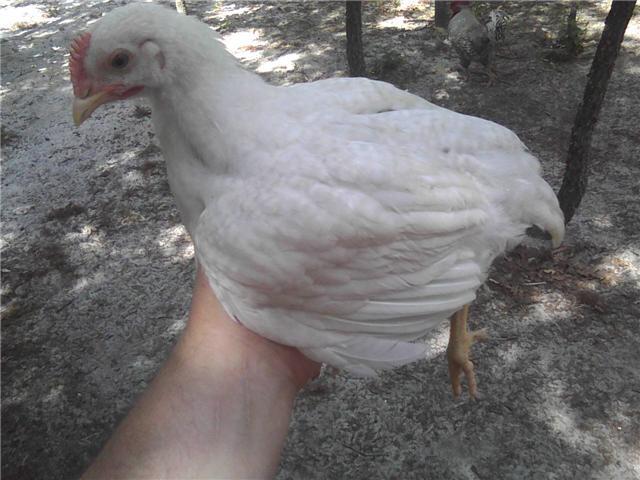
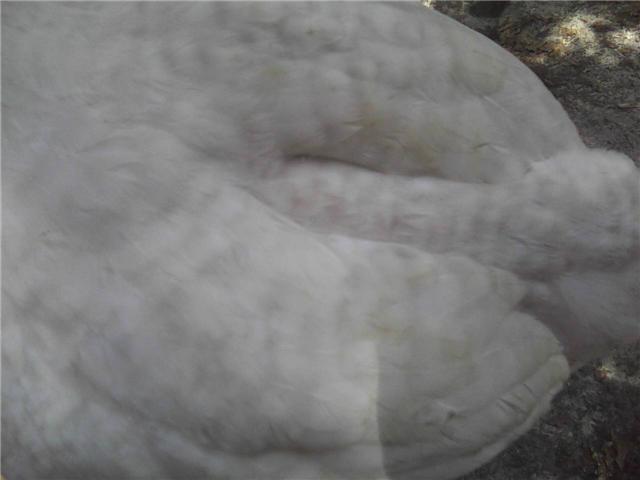
Cool Got any pics of them ? And yes when the roo is homozygous barred then all of his chicks should be barred regardless of the hen unless she carrys dom white then the chicks will still technically be barred, it would just be masked by white but may still come through as "ghost barring"
Here is a cockerel with ghost barring. He is from a Het. Barred Black Sexlink Rooster on a hatchery RIWhite hen with Dom. White.


Yes the little rooster I have looks very similar, maybe slightly darker barring, but the pullet has a much more distinct barring. I don't have any pictures as of now, but I will take some tomorrow and post. This is all so very interesting to me, thanks for sharing your expertise with me.
This pullet right here, while looking white, is actually a Splash cochin that for some reason never displayed any blue feathers. She was bluish gray as a chick and the breeder I got her from doesn't have any white cochins--just blue, black and splash in that breeding pen. So if I were to breed her to blue, she would probably have blue or splash offspring.
As a chick. She's the little bluish one to the left of the large blue one.
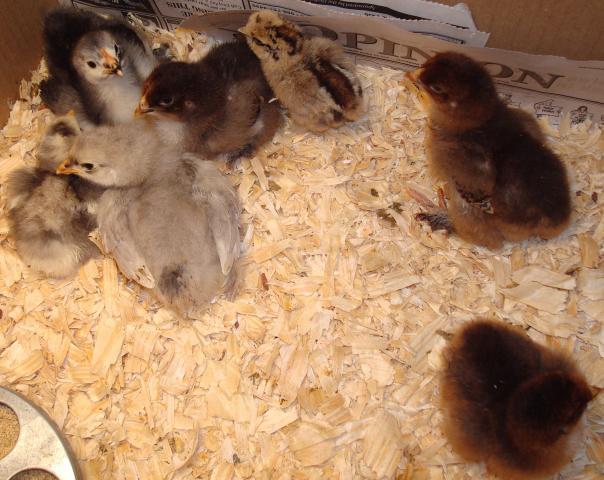
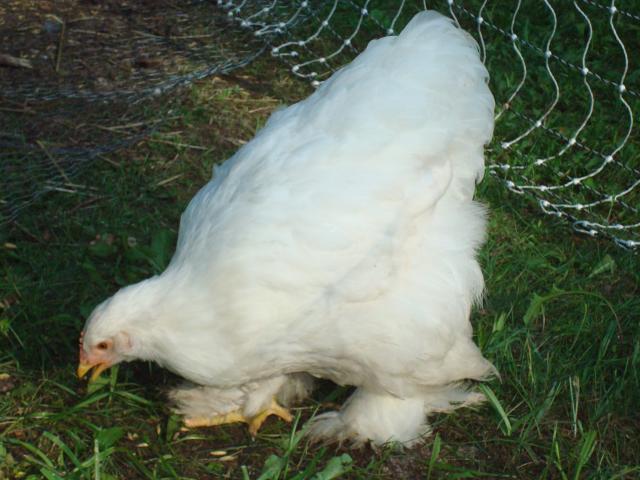
And her with her sisters
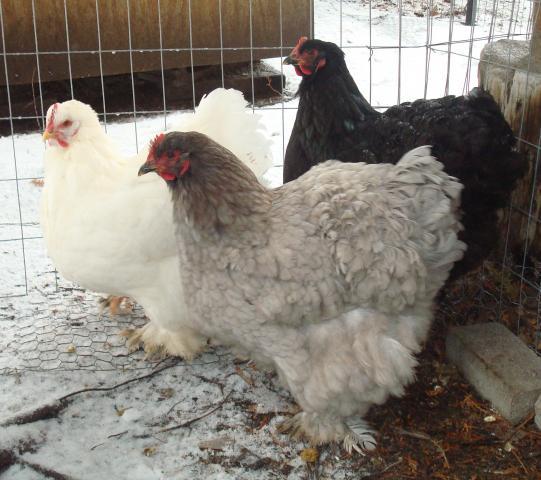
I'm curious what she'll produce with our partridge cochin.
As a chick. She's the little bluish one to the left of the large blue one.


And her with her sisters

I'm curious what she'll produce with our partridge cochin.
Last edited:
- Aug 24, 2010
- 879
- 2
- 121
And speaking of BBS cochins...look at this little one. All that red coming through. I was assuming she's going to be splash. Looks like red lacing but maybe barring?
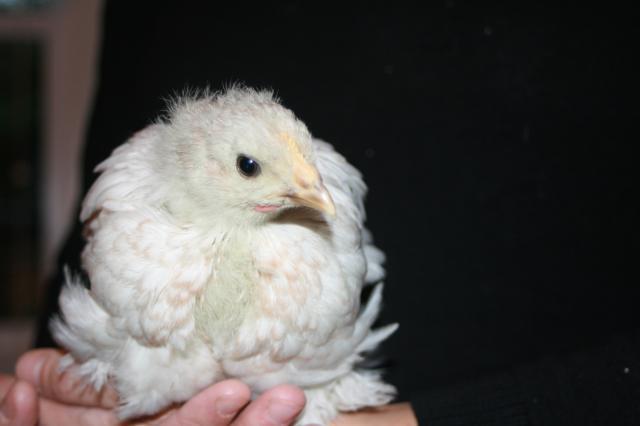

- Thread starter
- #8
Quote:
Pretty bird. Post a grown up pic when the time comes.
Pretty bird. Post a grown up pic when the time comes.
Here are my two ghost barring chicks. Sorry not the best pictures, they were being shy and the lighting isn't the best but you can see the barring.
Pullet


Roo


Now the question is if I breed them together (they have the same dad, Barred rock, but different white rock mom's) will I get more ghost barred chicks? Or will the barring be darker?
Pullet


Roo


Now the question is if I breed them together (they have the same dad, Barred rock, but different white rock mom's) will I get more ghost barred chicks? Or will the barring be darker?
Similar threads
- Replies
- 10
- Views
- 484
- Replies
- 8
- Views
- 938
- Replies
- 7
- Views
- 469
New posts New threads Active threads
-
Latest threads
-
-
-
-
-
Wry Neck & Immobility: When is it time to give up?
- Started by Kjohappy
- Replies: 2
-
-
Threads with more replies in the last 15 days
-
There is a time and place for shenanigans. (edit: THIS is that time and place)
- Started by azurbanclucker
- Replies: 420
-
Caged Bird and Parrot Thread!!!!
- Started by ShrekDawg
- Replies: 298
-
-
-
Open Contest BYC's 4th of July Star Spangled Hatch-Along—Stars, Stripes, & Feathers, a Text-to-Image Contest
- Started by Debbie292d
- Replies: 138
-


